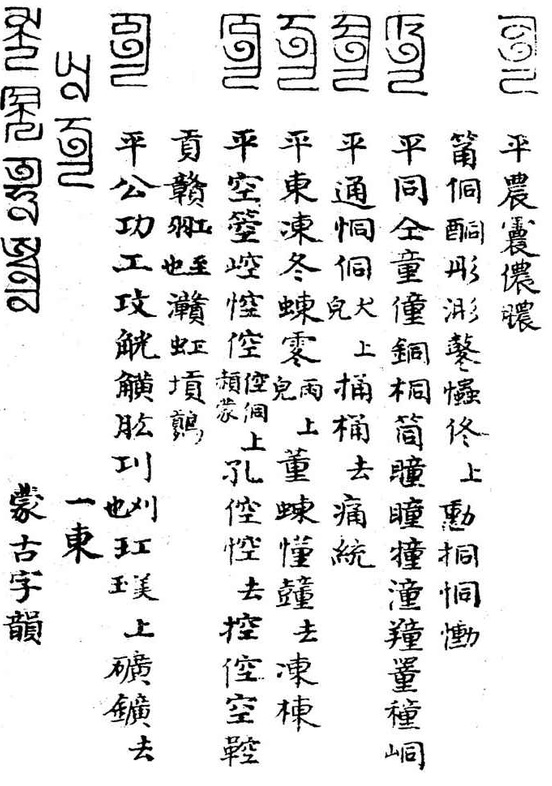Menggu ziyun 蒙古字韻 "Rhyme [dictionary] in Mongolian script" is a syllabary from the Yuan period 元 (1279-1368). It was compiled between 1269 and 1292. The Menggu ziyun is a dictionary of Chinese characters arranged in rhyme groups that are transcribed in 'Phags-pa script.
A printed version existed until the early 19th century, when it went lost. The only preserved specimen is an annotated print from 1308 kept in Japan. It is 2-juan long and includes forewords by Liu Geng 劉更 and the commentator Zhu Zongwen 朱宗文, as well as conversion tables.
The words or characters are grouped into 15 rhymes, in a mode very different from the traditional Chinese rhyme pattern (see Guangyun rhymes 廣韻), in other words, a simplified pattern to the 206 Guangyun and the 106 Pingshui rhymes 平水韻. The rhyme syllables are written in 'Phags-pa script, followed by an uncommented list of Chinese characters. The lists begin with an indication of the tone pitch.
The dictionary contains 814 rhyme syllables in 'Phags-pa script. The text of approximately 35 syllables is thought to be lost. The index of the Menggu ziyun includes a list of the rhyme groups, a list of she 攝 rhyme initials, and several lists of the 'Phags-pa alphabet.
| 1 東 2 庚 3 陽 4 支 5 魚 6 隹 7 真 8 寒 9 先 10 蕭 11 尤 12 覃 13 侵 14 歌 15 麻 |
 |
Example from the Menggu ziyun. The text is written in columns from left to right, following the structure of the Syriac script which was the ancestor of the Mongolian script. The headlines are the pronunciation of the homophoneous groups. The lists only contain homophoneous characters, without explanation. The Menggu ziyun is not a dictionary explaining the meaning of the words but only a list of characters. The left column is the title of the book, written in 'Phags-pa script (top) and in Chinese (below), the second column the headline of the first (一) rhyme group /-uŋ/, again written in 'Phags-pa and Chinese, with the representative character 東. The third column (including the next) contains all homophoneous characters pronounced ꡂꡟꡃ /guŋ/. The first character, ping 平, indicates the even-leveled tone pitch. The first group of homophones is 公 功 工 攻 觥 觵 肱 㓚 (same as 刈) 玒 and 𤧞, followed by words in the raising tone pitch (shang 上, bottom of the fourth column) 礦 鑛 and those in the falling tone pitch (qu 去) 貢 贛 羾 (means "to arrive"} 灨 虹 𡎴 and 𪄌. The next columns list the homophones pronounced 空 ꡁꡟꡃ /kuŋ/, 東 ꡊꡟꡃ /duŋ/, 通 ꡉꡟꡃ /tuŋ/, 同 ꡈꡟꡃ /tʰuŋ/ (two columns) and 農 ꡋꡟꡃ /nuŋ/. Xuxiu siku quanshu 續修四庫全書 edition. |